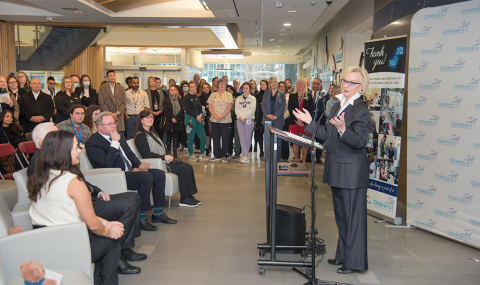Skip to main content
Accessibility Plan
2024-2029 Accessibility Plan
London Health Sciences Centre (LHSC) is committed to the identification, removal and prevention of accessibility barriers in compliance with standards that have been established under the Accessibility for Ontarians with Disabilities Act, 2005 (AODA).
We are equally committed to advancing accessibility and inclusion in which employees, physicians, volunteers, learners, patients, care partners and visitors with disabilities can access programs, services, and facilities, including buildings, public spaces, information and communications, in a way that meets their individual needs.
Our 2024-2029 Accessibility Plan outlines the goals and initiatives to advance accessibility and inclusion at LHSC. This plan is still in draft form. By providing your feedback, you will help strengthen our approach to addressing barriers to accessibility and inclusion at LHSC and enable us to prioritize improvements that matter the most.
General Accessibility
LHSC will actively seek feedback regarding the accessibility of programs and services from Team LHSC and the communities we serve.
Initiatives
Establish an accountability framework and performance monitoring dashboard for the implementation of the Accessibility Plan.
Develop relevant departmental action plans which will include detailed deliverables and timelines.
Develop, maintain and monitor accessibility guidelines and tools to support implementation and AODA compliance assurance.
Continue to engage and partner with disability communities to advance accessibility.
Ensure community engagement events are accessible and inclusive with consideration to equity-denied communities.
Develop an Employee Resource Group for staff with disability to identify and provide recommendations to the removal of accessibility barriers, and to provide guidance on the implementation of the Multi-year Accessibility Plan.
Develop an equity lens tool to assist staff with considering equity impacts when planning projects, policies and initiatives.
Develop corporate indicators to monitor and evaluate the advancement of accessibility and inclusion at LHSC.
Ensure accessibility considerations are integrated within the new Safety Incident Management System.
Training
LHSC will ensure that all individuals who deliver goods or services on behalf of LHSC are provided training regarding the requirements of Ontario’s accessibility laws and the Ontario Human Rights Code.
Initiatives
Update existing Accessibility iLearn modules for front-line staff and leaders around AODA and Human Rights legislation.
Provide education to staff around support persons, service animals and legislative responsibilities under AODA.
Ensure that Team LHSC training activities, course materials and learning approaches are developed and delivered using best practices for creating accessible content.
Identify and implement training opportunities for staff in a variety of areas related to anti-racism and anti-oppression including ableism and intersectionality; trauma and violence-informed care and harm reduction.
Procurement
LHSC will ensure that accessibility criteria and features are incorporated when procuring or acquiring goods, services or facilities.
Initiatives
Work with supply vendor to ensure accessibility criteria are key requirements of the procurement process when acquiring or purchasing goods, services and/or facilities.
Provide tools and resources to assist staff involved in procurement activities to meet accessibility obligations, such as training, templates, sample language and guidelines that embed accessibility considerations at all stages of procurement.
Develop vendor contract provisions for AODA and Human Rights Legislation training requirements, as well as a declaration of compliance with Anti-Harassment / Discrimination Legislation; in addition to updating LHSC’s policy for all procurement contracts.
Self-service Kiosks
LHSC will ensure that accessibility features are incorporated when designing, procuring or acquiring self-service kiosks.
Initiatives
Review and update existing wayfinding self-service kiosks to ensure accessibility features are being optimized.
Customer Services
LHSC will ensure that its policies, practices and procedures respect dignity, independence, integration, and equal opportunity for persons with disabilities.
Initiatives
Ensure safe and appropriate assistive devices such as wheelchairs and lifts are accessible to patients and staff.
Identify opportunities to enhance wayfinding and navigational support to persons with disabilities while attending LHSC for care.
Update the LHSC Accessibility for Persons with Disability Policy.
Implement on-demand video remote ASL interpretation services across LHSC.
Integrate accessibility considerations in the budget and capital planning processes.
Employment
LHSC will support the recruitment of potential employees and retention of current employees by ensuring that policies, practices, and workplaces are accessible.
Initiatives
Examine job requirements and minimum qualifications to reduce barriers to application for persons with disabilities and ensure only bona fide qualifications are listed.
Develop and implement an employment strategy for equity-denied groups, including persons with disabilities.
Complete an Employment Systems Review consisting of a review of Human Resources policies and procedures to identify, remove and prevent systemic employment barriers with a focus on recruitment, promotion and career development. Conducting an employee survey about the experience of equity, inclusion and accessibility at LHSC with a particular focus on equity-denied communities.
Develop and conduct an employee census survey to inform priorities for advancing equity, inclusion and accessibility at LHSC.
Develop education for leaders on accommodations, inclusion, and anti-ableism in performance management.
Ensure equity and inclusion is embedded in the Healthy Workplace Strategy.
Expand mental health resources and benefits for LHSC staff.
Information and Communication
LHSC will communicate using a variety of methods and techniques to ensure that information is available to all employees and community members in a format that best suits their needs.
Initiatives
Identify a corporate suite of accessible communication aids for staff caring for persons who are deaf, hard of hearing, blind and/or other visual abilities.
Provide education to staff about the availability of accessible formats and communication supports.
Continue to evaluate and remediate LHSC website content and web applications to ensure that they meet or exceed accessibility compliance requirements by providing the appropriate frameworks, tools, guidelines and training for use by content creators.
Review and update corporate signage and wayfinding guidelines to embed inclusion and accessibility considerations.
Ensure ongoing accessible document training and support for accessible document revision.
Create online video tutorials for staff on how to revise common accessibility errors and concerns in corporate documents.
Update the LHSC and Children’s Hospital Patient Handbooks to ensure they are accessible and inclusive.
Design of public spaces
LHSC will ensure that all newly constructed or significantly renovated public spaces, are accessible to Team LHSC and the community.
Initiatives
Continue to prioritize and retrofit existing built environment barriers to comply with the Ontario Building Code.
Continue to implement accessibility improvements, prioritizing the installation of automated buttons for washrooms and doors in public corridors.
Continue to maintain accessible elements in public spaces through monitoring and regularly planned preventative maintenance of accessible amenities.
Continue to respond to temporary disruptions when accessible elements in public spaces are not in working order by notifying the public and prioritizing remediation.
Upgrade existing outdoor eating areas to include accessible seating and clear pathways to access them.
Complete an accessibility audit of public spaces in order to create a prioritized list of accessibility enhancements.
Develop resources to build Facilities Management expertise around inclusive design.


